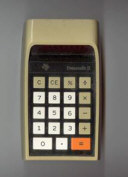
DATAMATH CALCULATOR MUSEUM
 |
DATAMATH CALCULATOR MUSEUM |
Canon F-2
| Date of introduction: | 1975 | Display technology: | Fluorescent |
| New price: | Display size: | 7 + 2 | |
| Size: | 6.5" x
3.3" x 1.25" 164 x 84 x 32 mm3 |
||
| Weight: | 6.2 ounces, 176 grams | Serial No: | 300966 |
| Batteries: | 3*AA | Date of manufacture: | year 1975 |
| AC-Adapter: | AD-1 | Origin of manufacture: | Japan |
| Precision: | 7 | Integrated circuits: | ZA0535 |
| Memories: | |||
| Program steps: | Courtesy of: | Joerg Woerner |
 On a
first glance the Palmtronic F-2 could be called a scientific calculator.
You'll easily notice keys like ax, log or D»R and even EXP to enter
the exponent of a number. Using the calculator is quite funny: The display is
always in a mode with 7 digits of mantissa and 2 digits of exponent and the 7
digits define the precision of the calculator.
On a
first glance the Palmtronic F-2 could be called a scientific calculator.
You'll easily notice keys like ax, log or D»R and even EXP to enter
the exponent of a number. Using the calculator is quite funny: The display is
always in a mode with 7 digits of mantissa and 2 digits of exponent and the 7
digits define the precision of the calculator.
Even a simple operation like the square root of 9 takes a
whooping 4 seconds and ends in a display of 2.99998
00! Funny to tell that the leftmost digit of the display counts
some numbers during calculation time.
Immediately a second question will arise: 32= ? Entering the numerals
and instructions is an interesting exercise:
| Key | Display | |
| [CL] | 0. 00 | |
| [3] | 3. 00 | |
| [ax] | .477124 00 | |
| [2] | 2. 00 | |
| [=] | 9.00009 00 |
A deeper exploration of the keyboard gives some other mismatches like a missing memory and the trigonometric functions without their inverse counterpart. The internal construction shows a LSI MOS chip of the TMS1000 family similar to the one in the Texas Instruments SR-16. But the algorithms seem to be much less perfect, we know similar performance from the F-7.
Even Texas Instruments failed with some algorithm, don't miss the rare SR-40 Prototype.
The same housing was used with the F-6
in Canon's scientific calculator line and the Palmtronic LD-10M
basic calculator.
If you have additions to the above article please email: joerg@datamath.org.
© Joerg Woerner, July 2, 2002. No reprints without written permission.